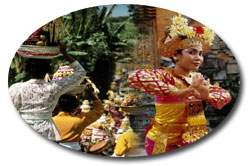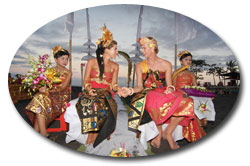Description of Puri Banyuning
The Story of Dinasty
In the past, Bali was divided into several kingdoms and the thrones were passed by generation. The Kings in some districts in Bali had governed for many decades. Though the aristocrat system disappears the higher class people and priests are still highly respected. Among dinasties of traditional rulers in Bali , the dinasty of Mengwi is among the most respected ones.
I Gusti Agung Banyuning was one among the sons of first ruler of Mengwi, I Gusti Agung Ngurah Made Agung or Tjokorde Sakti Blambangan, who was the founder of the Kingdom of Mengwi . Established around 17 th century, in their golden years Mengwi’s power dominated the island of Bali . The powerful influence of the kingdom was spreading as far as South Bali, Buleleng, Jembrana and Blambangan, in the eastern tip of East Java . To secure his power, the King also established some satelite palaces, with the centre royal palace situated in Kawiapura/Mengwi.
Each satelite palace was respectively ruled by one of his son or his loyal followers. To name some of the palace and the head of respective palace: his third son was resided in Payangan palace, I Gusti Agung Ketut Buleleng (the second son) headed the palaces of Muncan, Kapal, while I Gusti Ngurah Teges in Kaba-Kaba, I Gusti Ngurah Panji Wayahan in Buleleng, I Gusti Ngurah Jembrana in Jembrana.
His ninth son, I Gusti Agung Banyuning resided and ruled the palace of Sayan , Gianyar. However, in 1770s, during the reign of the late fifth king of Mengwi, I Gusti Agung Made Munggu alias Tjokorde Ngurah Made Agung, some regions under Mengwi authority were formally granted to the neighbouring kingdoms. The regions of Padang Luah, Dalung, Gaji, Kuta and Jimbaran were granted to Badung kingdom, while Blahbatuh, Sayan, Kedewatan were granted to Dewa Manggis, the king of Gianyar.
Proceding the historical changes, I Gusti Agung Gede Banyuning – the grandson of the first ruler of Puri Banyuning – was moved to the village of Bongkasa, in the district of Abiansemal, to establish another satelite palace under the name of Puri Banyuning Bongkasa. To maintain the memories of his previous palace in Sayan – Ubud, some areas under his authority was dubbed with the name of areas around his former palace in Sayan. Until now, we could find banjar Sayan, banjar Kedewatan and banjar Tanggayuda, around Sayan, Gianyar.
There have been many changes accurred during three centuries, in eighteen century the kingdom of Mengwi was gradually lost its power, and some kingdoms took over their power over the island. In 1906, the Dutch took over the whole island of Bali under their colonial power. In 1930s, the colonial interventions completed a process in which the largely fluid character of southern Balinese political system virtually disappeared. In 1945 Republic of Indonesia was born, and the new political system was introduced. From the course of the time, the political power of traditional palaces have gradually disappeared. However, the Bongkasa palace managed to retain their traditional influence, particulary at the village level, because their landed property remain largely untouched and their leaders functioned as village heads. Some representatives of the puri pursued careers in the Indonesian bureaucracy, some attaining high positions. A number of individuals became wealthy through the building of trade and their involvement in the tourism. In a nutshell, members of the aristocracy of Banyuning Bongkasa palace could enter their modern era without loosing the traditional respect from their people.
For the villagers of Bongkasa, the palace of Banyuning Bongkasa is still regarded as the residence of their traditional leaders. It was particulary obvious during the royal cremation of the Prince of Bongkasa, I Gusti Agung Gede Oka, on the 18 th of May 1997 . The event was a magnificent and a touching one, as in Bali the more beloved the deceased it seems the more composed the mourners.
I Gusti Agung Gede Oka – a direct descendant of the ruler of Puri Banyuning Bongkasa, was formerly the Head of the Education and Cultural Department of Bali. He has renovated the palace of Banyuning Bongkasa and his wife, Ida Ayu Kompiang Sutarti, continued his work and later on, the palace is opened for public. The palace – “puri” in Bali or “keraton” in Java – is traditionally the center of social and cultural activities for the local community. Nowadays, the palace or “puri” of Banyuning Bongkasa has found its new cultural role in the world of modern tourism.
Once in a Lifetime

Balinese Procession And Dance
The sounds of traditional gamelan orchestra always accompany the elegant movements of Balinese dancers. The kind of instrument vary from traditional metallophone to drums, and there are some instruments made of bamboo or wood. There are always dances performed for big ceremonies in the villages or in the palaces. For the Balinese, any dances are not only movements, during special ceremonies they are considered as offering to Gods or ancestors.
You will enjoy various kind of dances and performance during your visit to Puri Banyuning Bongkasa. The Balinese love to do to watch performances in their daily life, as dances is part on many rituals.
Mother take children to learn and to watch dances, you could see how they enjoy perfomance in their own way. Actually, many things happened before and around the stage of perfomance.
Besides these perfomance a photo session with the royal family og Bongkasa is a rare oppurtunity your could have. The next cultural step is the life of Balinese palace. Offerings in Bali are always made of natural objects, and women are usually the markers. This is a common scene during everyday life in Bali.
Almost everyday, the Balinese, especially in the palace or the Brahmin residence, read the verses of holy scriptures, from Mahabarata, Ramayana epic, or passive spectators, the dance learning session is possibly another aspect of your once in a life time experience.
Try to move your hand and fingers in delicate manner as the Balinese dancers do. But dances are not the whole aspects of Balinese strong tradition. Traditional visual art is another. Craftsmanship has Made Bali very famous, because the island produce a wide range of traditional and modern art handycrafts, for decorate purpose or souvenirs. The only thing you need to have for taking those souvenirs home is your bargain skill. Find the souvenirs you like, and see which one get cheapest price !!

Cocktail Parties And Dinning
Culture is also reflected in the dishes. balinese believe that the love comes from the sight and the food. Try those cakes and cookies, find out how people could fall in love by them. Believe it or not, selling cookies is an old customs for girls to find the love of life in Bali.
Its particular rice cultivitation system has make Bali famous for centuries, and Puri Banyuning Bongkasa, in the old days, was an important centre of rice cultivation system. Balinese rice is not only staple food, but the taste of original Balinese riceis delicious.
There is is always a variety of dishes for your plate. Bite some Balinese cuisine for you to make this experience complete. Balinese food is sometimes hot and spicy, but you can always ask the staff to choose a milder dish for you.

Traditional Wedding Ceremony
Puri Banyuning Bongkasa – A perfecet and idyllic place to arrange an unforgettable wedding ceremony and wedding reception
Couples who wish to arrange their wedding arrangements could experience this perfect event of a lifetime according to the couple’s religious believe or to simply tying the knot for the exchange of the second vows of love and devotion.
Afterwards, in A Royal Custom-designed Balinese Wedding blessing ceremony could then be arrange.

